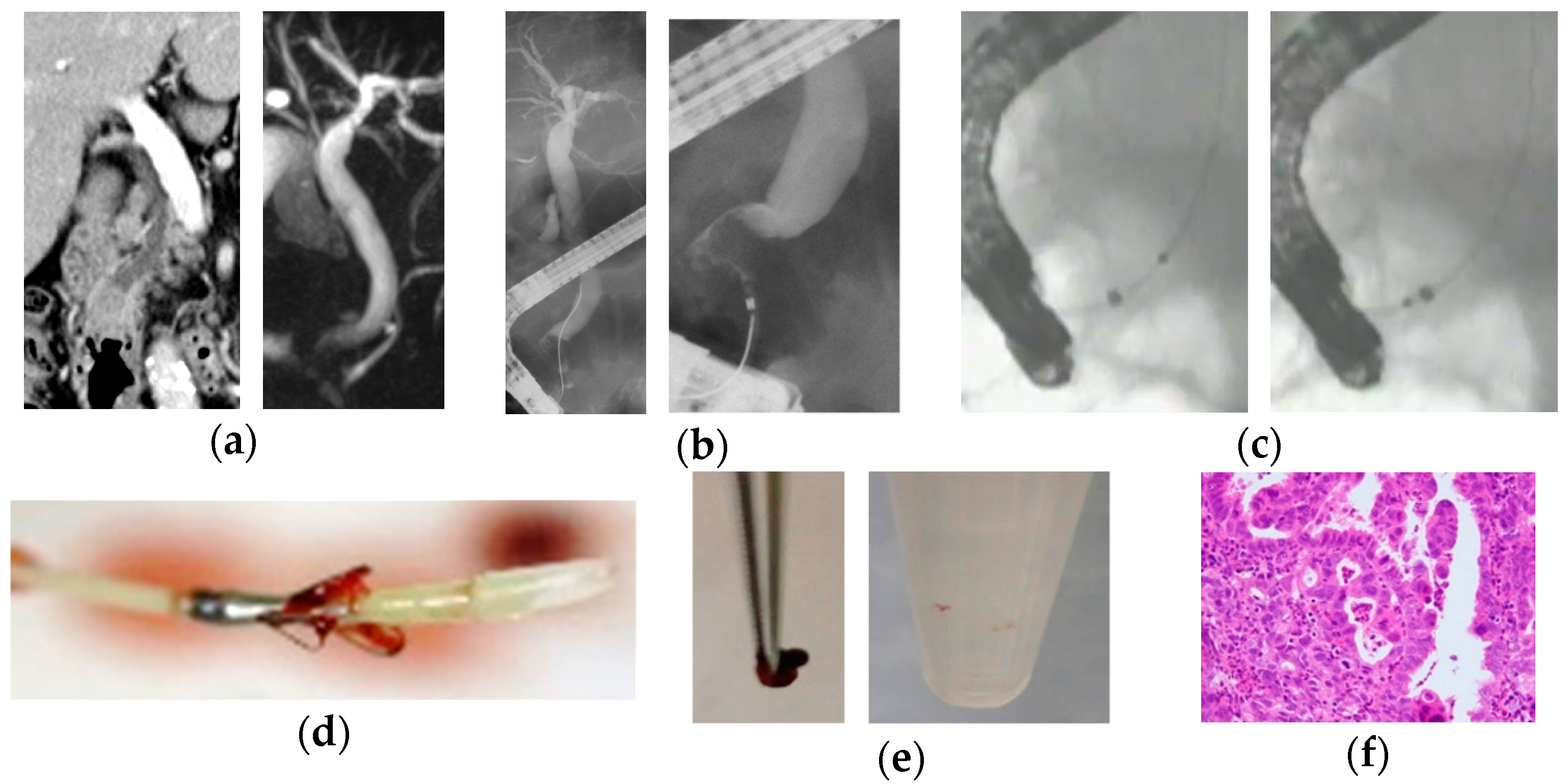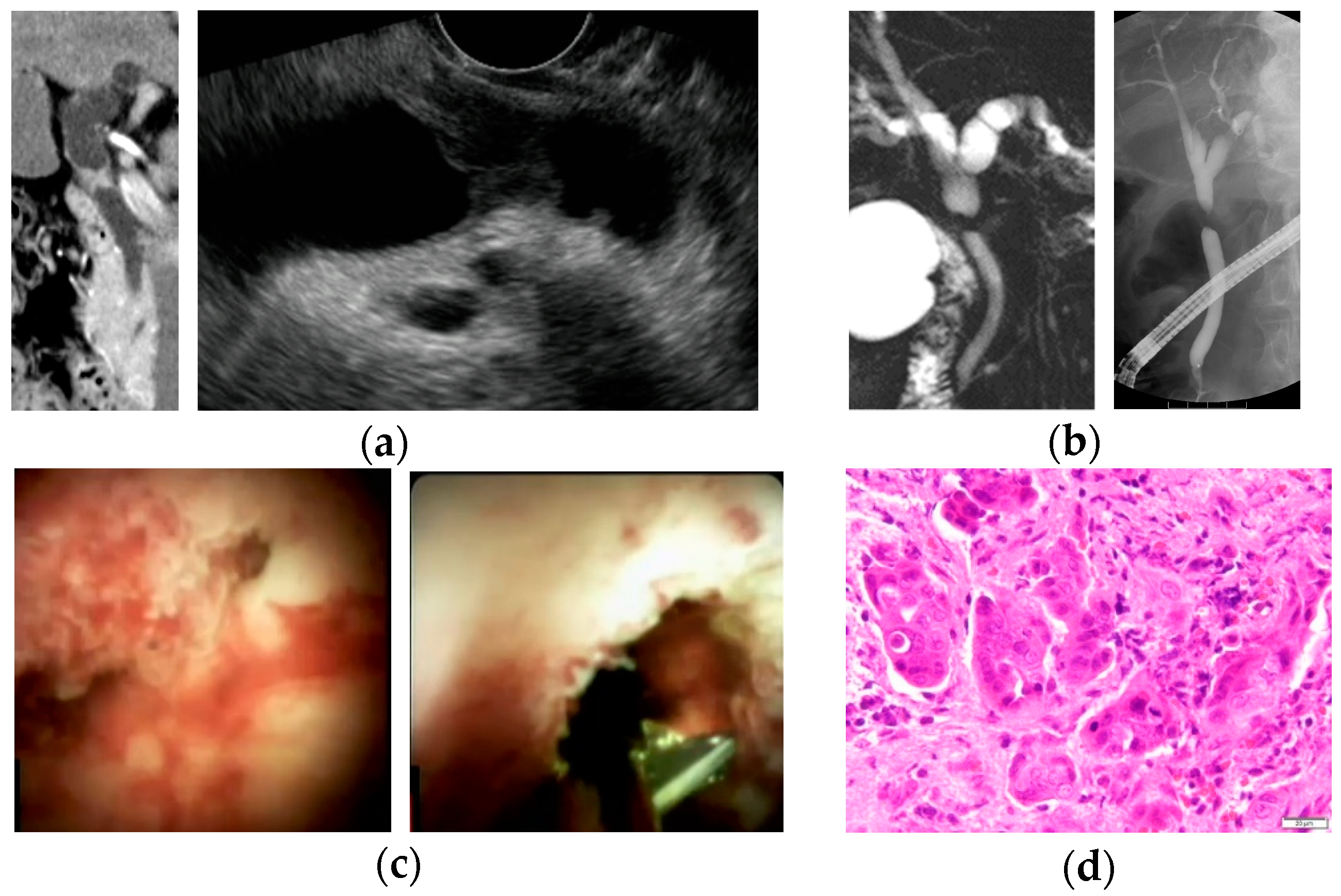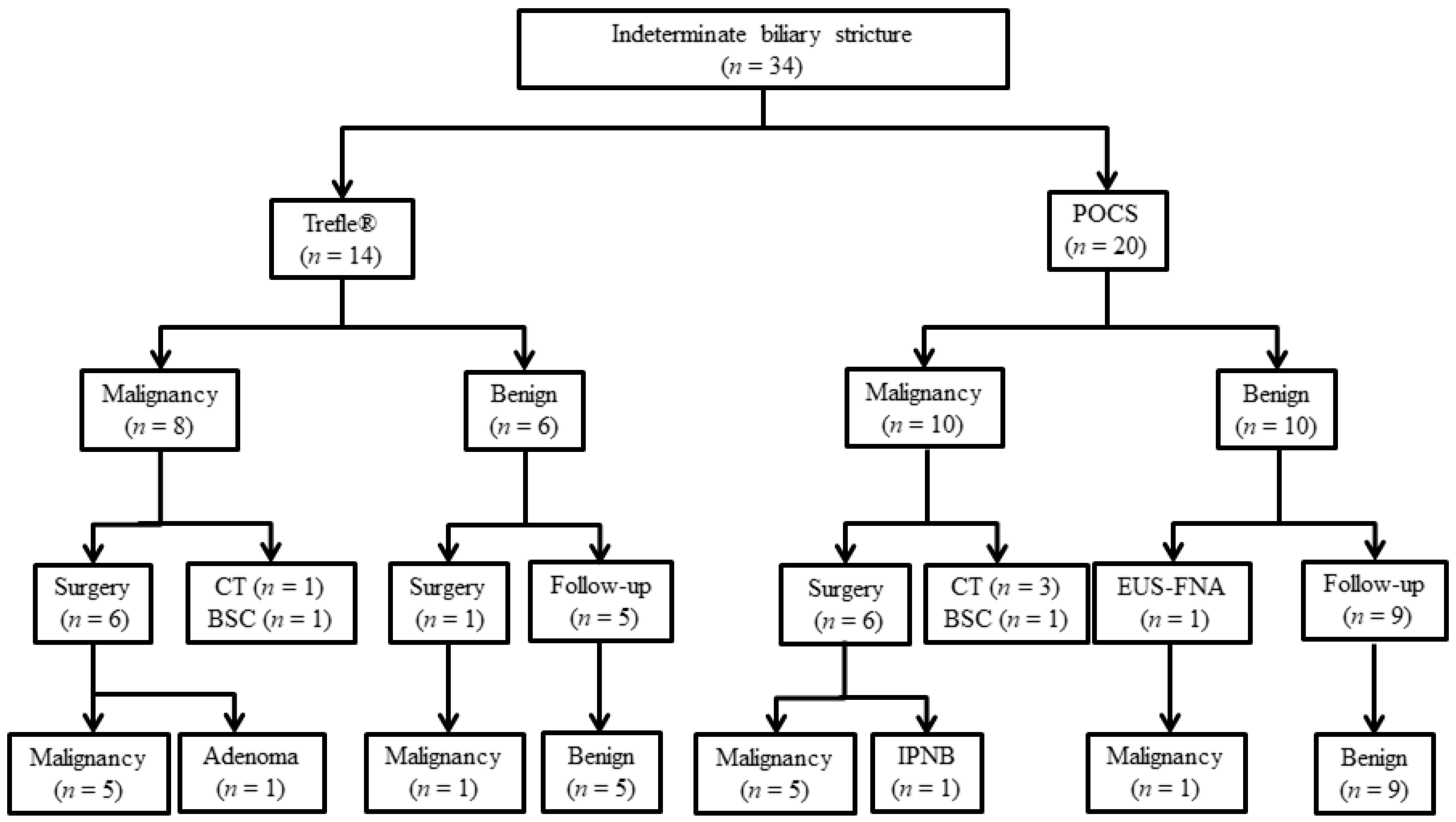Peroral Cholangioscopy-Guided Forceps Biopsy and Endoscopic Scraper for the Diagnosis of Indeterminate Extrahepatic Biliary Stricture
Abstract
1. Introduction
2. Materials and Methods
2.1. Study Population
2.2. Endoscopic Procedure
2.3. Diagnostic Criteria
2.4. Statistical Analysis
3. Results
3.1. Patient’s Characteristics and Baseline Evaluation
3.2. Diagnostic Ability of Trefle® and POCS-Guided Tissue Acquisition for Extrahepatic Cholangiocarcinoma
3.3. Adverse Events
4. Discussion
5. Conclusions
Author Contributions
Conflicts of Interest
References
- Flemming, J.A.; Zhang-Salomons, J.; Nanji, S.; Booth, C.M. Increased incidence but improved median overall survival for biliary tract cancers diagnosed in Ontario from 1994 through 2012: A population-based study. Cancer 2016, 122, 2534–2543. [Google Scholar] [CrossRef] [PubMed]
- Ishihara, S.; Horiguchi, A.; Miyakawa, S.; Endo, I.; Miyazaki, M.; Takada, T. Biliary tract cancer registry in Japan from 2008 to 2013. J. Hepato-Biliary-Pancreat. Sci. 2016, 23, 149–157. [Google Scholar] [CrossRef] [PubMed]
- Wakai, T.; Shirai, Y.; Sakata, J.; Maruyama, T.; Ohashi, T.; Korira, P.V.; Ajioka, Y.; Hatakeyama, K. Clinicopathological features of benign biliary strictures masquerading as biliary malignancy. Am. Surg. 2012, 78, 1388–1391. [Google Scholar] [PubMed]
- Burnett, A.S.; Calvert, T.J.; Chokshi, R.J. Sensitivity of endoscopic retrograde cholangiopancreatography standard cytology: 10-y review of the literature. J. Surg. Res. 2013, 184, 304–311. [Google Scholar] [CrossRef] [PubMed]
- Navaneenthan, U.; Njei, B.; Lourdusamy, V.; Konjeti, R.; Vargo, J.J.; Parsi, M.A. Comparative effectiveness of biliary brush cytology and intraductal biopsy for detection of malignant biliary strictures: A systematic review and meta-analysis. Gastrointest. Endosc. 2015, 81, 168–176. [Google Scholar] [CrossRef]
- Draganov, P.V.; Chauhan, S.; Wagh, M.S.; Gupte, A.R.; Lin, T.; Hou, W.; Forsmark, C.E. Diagnostic accuracy of conventional and cholangioscopy-guided sampling of indeterminate biliary lesions at the time of ERCP: A prospective, long-term follow-up study. Gastrointest. Endosc. 2012, 75, 347–353. [Google Scholar] [CrossRef]
- Walter, D.; Peveling-Oberhag, J.; Schulze, F.; Bon, D.; Zeuzem, S.; Friedrich-Rust, M.; Albert, J.G. Intraductal biopsies in indeterminate biliary stricture: Evaluation of histopathological criteria in fluoroscopy- vs. cholangioscopy guided technique. Dig. Liver Dis. 2016, 48, 765–770. [Google Scholar] [CrossRef]
- Sakuma, Y.; Kodama, Y.; Sogabe, Y.; Nakai, Y.; Yamashita, Y.; Mikami, S.; Kajimura, K.; Ikeda, K.; Tamaki, H.; Iwamoto, S.; et al. Diagnostic performance of a new endoscopic scraper for malignant biliary strictures: A multicenter prospective study. Gastrointest. Endosc. 2017, 85, 371–379. [Google Scholar] [CrossRef]
- Navaneethan, U.; Hasan, M.K.; Lourdusamy, V.; Njei, B.; Varadarajulu, S.; Hawes, R.H. Single-operator cholangioscopy and targeted biopsies in the diagnosis of indeterminate biliary strictures: A systematic review. Gastrointest. Endosc. 2015, 82, 608–614. [Google Scholar] [CrossRef]
- Weilert, F.; Bhat, Y.M.; Binmoeller, K.F.; Kane, S.; Jaffee, I.M.; Shaw, R.E.; Cameron, R.; Hashimoto, Y.; Shah, J.N. EUS-FNA is superior to ERCP-based tissue sampling in suspected malignant biliary obstruction: Results of a prospective, single-blind, comparative study. Gastrointest. Endosc. 2014, 80, 97–104. [Google Scholar] [CrossRef]
- Sadeghi, A.; Mohamadnejad, M.; Islami, F.; Keshtkar, A.; Biglari, M.; Malekzadeh, R.; Eloubeidi, M.A. Diagnostic yield of EUS-guided FNA for malignant biliary stricture: A systematic review and meta-analysis. Gastrointest. Endosc. 2016, 83, 290–298. [Google Scholar] [CrossRef] [PubMed]
- Onoyama, T.; Matsumoto, K.; Takeda, Y.; Kawata, S.; Kurumi, H.; Koda, H.; Yamashita, T.; Takata, T.; Isomoto, H. Endoscopic Ultrasonography-Guided Fine Needle Aspiration for Extrahepatic Cholangiocarcinoma: A Safe Tissue Sampling Modality. J. Clin. Med. 2019, 8, 417. [Google Scholar] [CrossRef] [PubMed]
- Heimbach, J.K.; Sanchez, W.; Rosen, C.B.; Gores, G.J. Trans-peritoneal fine needle aspiration biopsy of hilar cholangiocarcinoma is associated with disease dissemination. HPB 2011, 13, 356–360. [Google Scholar] [CrossRef] [PubMed]
- El Chafic, A.H.; Dewitt, J.; Leblanc, J.K.; El Hajj, I.I.; Cote, G.; House, M.G.; Sherman, S.; McHenry, L.; Pitt, H.A.; Johnson, C.; et al. Impact of preoperative endoscopic ultrasound-guided fine needle aspiration on postoperative recurrence and survival in cholangiocarcinoma patients. Endoscopy 2013, 45, 883–889. [Google Scholar] [CrossRef] [PubMed]
- Victor, D.W.; Sherman, S.; Karakan, T.; Khashab, M.A. Current endoscopic approach to indeterminate biliary strictures. World J. Gastroenterol. 2012, 18, 6197–6205. [Google Scholar] [CrossRef] [PubMed]
- Onoyama, T.; Matsumoto, K.; Koda, H.; Yamashita, T.; Kurumi, H.; Kawata, S.; Takeda, Y.; Harada, K.; Yashima, K.; Isomoto, H. Diagnostic usefulness of KL-6 concentration of bile in biliary tract cancer. Mol. Clin. Oncol. 2018, 8, 567–570. [Google Scholar] [CrossRef] [PubMed]
- Osanai, M.; Itoi, T.; Igarashi, Y.; Tanaka, K.; Kida, M.; Maguchi, H.; Yasuda, K.; Okano, N.; Imaizumi, H.; Itokawa, F. Peroral video cholangioscopy to evaluate indeterminate bile duct lesions and preoperative mucosal cancerous extension: A prospective multicenter study. Endoscopy 2013, 45, 635–642. [Google Scholar] [CrossRef] [PubMed]
- Nishikawa, T.; Tsuyuguchi, T.; Sakai, Y.; Sugiyama, H.; Miyazaki, M.; Yokosuka, O. Comparison of the diagnostic accuracy of peroral video-cholangioscopic visual findings and cholangioscopy-guided forceps biopsy findings for indeterminate biliary lesions: A prospective study. Gastrointest. Endosc. 2013, 77, 219–226. [Google Scholar] [CrossRef]
- Ikeda, M.; Maetani, I.; Terada, K.; Ukita, T.; Tada, T.; Shigoka, H.; Omuta, S.; Takahashi, K. Usefulness of endoscopic retrograde biliary biopsy using large-capacity forceps for extrahepatic biliary strictures: A prospective randomized study. Endoscopy 2010, 42, 837–841. [Google Scholar] [CrossRef]
- Park, C.H.; Jung, J.H.; Nam, E.; Kim, E.H.; Kim, M.G.; Kim, J.H.; Park, S.W. Comparative efficacy of various endoscopic techniques for the treatment of common bile duct stones: A network meta-analysis. Gastrointest. Endosc. 2018, 87, 43–57. [Google Scholar] [CrossRef]
- Peng, Y.C.; Lin, C.L.; Sung, F.C. Risk of pyogenic liver abscess and endoscopic sphincterotomy: A population-based cohort study. BMJ Open 2018, 8, e018818. [Google Scholar] [CrossRef] [PubMed]
- Wakai, T.; Shirai, Y.; Moroda, T.; Yokoyama, N.; Hatakeyama, K. Impact of ductal resection margin status on long-term survival in patients undergoing resection for extrahepatic cholangiocarcinoma. Cancer 2005, 103, 1210–1216. [Google Scholar] [CrossRef] [PubMed]
- Igami, T.; Nagino, M.; Oda, K.; Nishio, H.; Ebata, T.; Yokoyama, Y.; Shimoyama, Y. Clinicopathologic study of cholangiocarcinoma with superficial spread. Ann. Surg. 2009, 249, 296–302. [Google Scholar] [CrossRef] [PubMed]
- Hijioka, S.; Hara, K.; Mizuno, N.; Imaoka, H.; Mekky, M.A.; Nagashio, Y.; Sekine, M.; Tajika, M.; Tanaka, T.; Ishihara, M.; et al. A novel technique for endoscopic transpapillary “mapping biopsy specimens” of superficial intraductal spread of bile duct carcinoma. Gastrointest. Endosc. 2014, 79, 1020–1025. [Google Scholar] [CrossRef] [PubMed]
- Nishikawa, T.; Tsuyuguchi, T.; Sakai, Y.; Sugiyama, H.; Kishimoto, T.; Ohtsuka, M.; Miyazaki, M.; Yokosuka, O. Preoperative assessment of longitudinal extension of cholangiocarcinoma with peroral video-cholangioscopy: A prospective study. Dig. Endosc. 2014, 26, 450–457. [Google Scholar] [CrossRef] [PubMed]
- Ogawa, T.; Ito, K.; Koshita, S.; Kanno, Y.; Masu, K.; Kusunose, H.; Sakai, T.; Murabayashi, T.; Hasegawa, S.; Noda, Y. Usefulness of cholangioscopic-guided mapping biopsy using SpyGlass DS for preoperative evaluation of extrahepatic cholangiocarcinoma: A pilot study. Endosc. Int. Open 2018, 6, E199–E204. [Google Scholar] [CrossRef] [PubMed]



| Parameter | Biliary Disease (n = 34) |
|---|---|
| Age (range), years | 71 (47–85) |
| Sex, male/female | 19/15 |
| Location of stricture (perihilar/distal) | 12/22 |
| Malignant | 6/12 |
| Benign | 6/10 |
| Length of stricture, mm | 16.2 (1.2–46.0) |
| Acute cholangitis (presence/absence) | 4/30 |
| Total bilirubin, mg/dL | 1.2 (0.3–25.4) |
| Tumor marker | |
| CEA, ng/mL | |
| Malignant | 2.4 (1.2–8.3) |
| Benign | 2.2(1.4–4.2) |
| CA19-9, U/mL | |
| Malignant | 57.9 (0.8–11985) * |
| Benign | 7.7 (1.6–71.6) |
| Malignant | 18 |
| cholangiocarcinoma | 18 |
| Benign | 16 |
| Benign biliary stricture | 11 |
| IgG4-associated sclerosing cholangitis | 1 |
| Primary sclerosing cholangitis | 1 |
| Intraductal papillary neoplasm of bile duct | 1 |
| Bile duct adenoma | 1 |
| Peribiliary cyst | 1 |
| Trefle® (n = 14) | POCS (n = 20) | p Value | |
|---|---|---|---|
| Age, years | 70.5 (53–85) | 71 (47–84) | 0.779 *1 |
| Sex, male/female | 8/6 | 11/9 | 0.901 *2 |
| Malignancy/Benign | 8/6 | 10/10 | 0.681*2 |
| Location (perihilar/distal) | 3/11 | 9/11 | 0.293 *2 |
| Length of stricture, mm | 18.4 (8.8–42.0) | 16.0 (1.2–46.0) | 0.431 *1 |
| Acute cholangitis (presence/absence) | 1/13 | 3/17 | 0.874 *2 |
| Total bilirubin, mg/dL | 1.1 (0.6–25.4) | 1.3 (0.3–14.8) | 0.972 *1 |
| Tumor marker (serum) | |||
| CEA, ng/mL | |||
| Malignant | 2.3 (1.2–4.8) | 2.5 (1.4–8.3) | 0.307 *3 |
| Benign | 2.0 (1.4–4.2) | 1.9 (1.6–3.1) | 0.609 *3 |
| CA19-9, U/mL | |||
| Malignant | 76.5 (0.8–11985.0) | 52.5 (17.8–577.6) | 0.271 *3 |
| Benign | 7.7 (7.1–13.6) | 7.6 (1.6–71.6) | 0.545 *3 |
| Trefle® (n = 14) | POCS (n = 20) | p Value | |
|---|---|---|---|
| Procedure time, minutes | 92.0 (57–129) | 85.5 (34–170) | 0.766 *1 |
| EST or precut papillotomy (previous/with/without) | 1/3/10 | 5/15/0 | <0.001 *2 |
| Number of biopsy, times | 2 (1–6) | 3 (2–9) | 0.0498 *1 |
| Sensitivity, % | Specificity, % | PPV, % | NPV, % | Accuracy, % | ||
|---|---|---|---|---|---|---|
| Trefle® | BAC | 87.5 | 100 | 100 | 85.7 | 92.9 |
| (7/8) | (6/6) | (7/7) | (6/7) | (13/14) | ||
| TB | 62.5 | 83.3 | 83.3 | 62.5 | 71.4 | |
| (5/8) | (5/6) | (5/6) | (5/8) | (10/14) | ||
| BAC + TB | 87.5 | 83.3 | 87.5 | 83.3 | 85.7 | |
| (7/8) | (5/6) | (7/8) | (5/6) | (12/14) | ||
| POCS | BAC | 40.0 | 100 | 100 | 60.0 | 68.4 |
| (4/10) | (9/9) | (4/4) | (9/15) | (13/19) | ||
| PB | 90.0 | 90.0 | 90.0 | 90.0 | 90.0 | |
| (9/10) | (9/10) | (9/10) | (9/10) | (18/20) | ||
| BAC + PB | 90.0 | 90.0 | 90.0 | 90.0 | 90.0 | |
| (9/10) | (9/10) | (9/10) | (9/10) | (18/20) |
| Adverse Event | Trefle® (n = 14) | POCS (n = 20) | p Value |
|---|---|---|---|
| Pancreatitis | 21.4 (3/14) | 15.0 (3/20) | 0.672 |
| Bleeding | 0 | 5.0 (1/20) | 1.000 |
| Infection | 14.3 (2/14) | 5.0 (1/20) | 0.555 |
| Perforation | 0 | 0 | NS |
| Cardiac | 0 | 0 | NS |
| Pulmonary | 0 | 0 | NS |
| Medication reaction | 0 | 0 | NS |
| Other | 0 | 0 | NS |
| Overall | 35.7 (5/14) | 25.0 (5/20) | 0.704 |
© 2019 by the authors. Licensee MDPI, Basel, Switzerland. This article is an open access article distributed under the terms and conditions of the Creative Commons Attribution (CC BY) license (http://creativecommons.org/licenses/by/4.0/).
Share and Cite
Kato, M.; Onoyama, T.; Takeda, Y.; Kawata, S.; Kurumi, H.; Koda, H.; Yamashita, T.; Hamamoto, W.; Sakamoto, Y.; Matsumoto, K.; et al. Peroral Cholangioscopy-Guided Forceps Biopsy and Endoscopic Scraper for the Diagnosis of Indeterminate Extrahepatic Biliary Stricture. J. Clin. Med. 2019, 8, 873. https://doi.org/10.3390/jcm8060873
Kato M, Onoyama T, Takeda Y, Kawata S, Kurumi H, Koda H, Yamashita T, Hamamoto W, Sakamoto Y, Matsumoto K, et al. Peroral Cholangioscopy-Guided Forceps Biopsy and Endoscopic Scraper for the Diagnosis of Indeterminate Extrahepatic Biliary Stricture. Journal of Clinical Medicine. 2019; 8(6):873. https://doi.org/10.3390/jcm8060873
Chicago/Turabian StyleKato, Masayuki, Takumi Onoyama, Yohei Takeda, Soichiro Kawata, Hiroki Kurumi, Hiroki Koda, Taro Yamashita, Wataru Hamamoto, Yuri Sakamoto, Kazuya Matsumoto, and et al. 2019. "Peroral Cholangioscopy-Guided Forceps Biopsy and Endoscopic Scraper for the Diagnosis of Indeterminate Extrahepatic Biliary Stricture" Journal of Clinical Medicine 8, no. 6: 873. https://doi.org/10.3390/jcm8060873
APA StyleKato, M., Onoyama, T., Takeda, Y., Kawata, S., Kurumi, H., Koda, H., Yamashita, T., Hamamoto, W., Sakamoto, Y., Matsumoto, K., & Isomoto, H. (2019). Peroral Cholangioscopy-Guided Forceps Biopsy and Endoscopic Scraper for the Diagnosis of Indeterminate Extrahepatic Biliary Stricture. Journal of Clinical Medicine, 8(6), 873. https://doi.org/10.3390/jcm8060873






